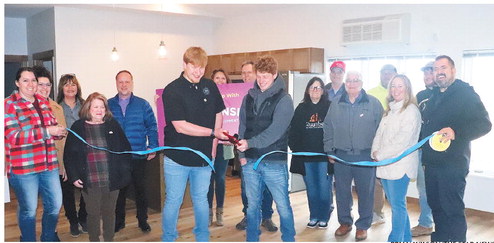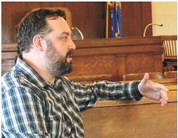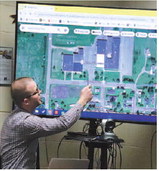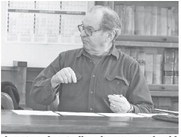Deer hunting is proposed at Big Eau Pleine Park
Hunters would be allowed to pursue whitetail deer in Big Eau Pleine Park as part of a proposed archery-only season that came before Marathon County supervisors last week.
Members of the Environmental Resources Committee (ERC) discussed the idea June 27 as one of several possible ordinance changes developed by the county’s Parks Commission and the Forestry and Recreation Committee.
Under the proposed ordinance change, bow hunters would be allowed to harvest deer from the 1,450-acre park from November 15 through the Sunday closest to January 6. Archers would have to stay at least 100 feet away from any designated trail or structure and could only hunt from an elevated stand.
Parks and forestry director Jamie Polley said the proposed rules are meant to ensure the safety of other park users while also encouraging a sizable deer harvest.
“We do have quite a large deer population in Big Eau Pleine,” she said.
Polley said the deer disrupt efforts to grow new trees in the park, and they also damage crops at neighboring farms, causing complaints over a number of years.
Supervisor Rick Seefeldt said the Park Commission heard from a farmer who counted 100 or so deer coming out of the park and onto his field at night. “Hopefully this will solve some of the problems out there,” he said.
The November 15 season opener matches the state park system, Polley noted, and it also comes a couple weeks after the campgrounds close on October 31.
Supervisor Tony Sherfinski wondered if the county had considered organizing a more “targeted hunt,” with hunters hired to methodically sweep through the park. Corporation counsel Michael Puerner said the county would most likely have to consult the Wisconsin DNR before proceeding with an abatement activity like that.
Committee chairman Jacob Langenhahn questioned how the county would protect the safety of other park users who aren’t likely to be wearing blaze orange during the hunt. Polley said the parks department will be putting up signs to educate the public.
“We don’t stop people from going into our county forests during hunting season,” she noted. “We just strongly suggest that you be aware that hunting is happening here and you dress appropriately.”
Although supervisors were supportive of the deer hunt, the committee eventually voted to send the proposal back to the Park Commission so language could be added about requiring hunters to remove their deer stands from the park when not in use.
In a related matter, the ERC endorsed a proposal from the Forestry and Recreation Committee to establish a winter season for fat tire biking at Nine-Mile County Forest. If adopted by the county board, the proposal would allow bikes with a tire width of at least 3.8 inches to use a designated trail system during the winter months.
Polley said the department did a trial season last year and got “very positive feedback.”
For the trial season, bikers paid $5 for a day pass and $20 for a season pass, but those rates may change for the permanent season depending on what the county board decides. A portion of the trail will be shared with snowshoers, but bicyclists must yield to snowshoers and cross-country skiers.
New trail signs will be added at the forest, both for fat tire biking and snowshoeing, Polley said. Improvements will also be made to the trail maps and the Parks and Forestry website, she noted.
Supervisor Sherfinski said he was glad to hear that updated signage is on the way.
“It is so out of date. What is out there isn’t even accurate,” he said. “So, hopefully by this winter, we’ll make some progress and make it a little bit more navigable.”
Another proposed ordinance change would bar people from hiking on trails groomed specifically for fat tire biking, snowshoeing or cross-country skiing. There’s also a proposal to clarify that dogs are only prohibited on designated cross-country skiing trails at Nine-Mile, and only during the ski season or when the trails are being groomed.
Other business
Shad Harvey, land resources manager, explained the process for doing a comprehensive revision of the county’s zoning code, which is done every 10 years. He said the review offers the county an opportunity to update its codes, allows citizens to provide input and enables townships to get out of county zoning if they desire. The process will start with sending out surveys to the townships in 2024, followed by meetings and hearings in 2025 and final approval in early 2026, he said.
Langenhahn said he would like to include a discussion about minimum lot sizes for residential properties, and how that affects the development of affordable housing.
Harvey told the committee that the town of Knowlton has petitioned the ERC to reduce the minimum lot size for residential properties that can keep chickens and other fowl. The proposal would allow a lot as small as a half-acre to keep up to six chickens, with one acre required for 12. The committee will discuss the proposal further at its next meeting.
The committee signed off on a proposed letter to Gov. Tony Evers and state lawmakers, calling for more local control on issues such as metallic mining, wind turbine siting, and runoff regulation for Concentrated Animal Feeding Operations (CAFOs).
Teal Fyksen, land use specialist, told the committee about proposed state law changes related to non-metallic mines, including a bill that would put an additional 30 to 35 mines under the jurisdiction of the county’s reclamation ordinance. The mine sites in question, which are currently regulated by the Wisconsin DNR, are those within 500 feet of navigable water. Fyksen said the county could charge fees to recoup 100 percent of its costs for overseeing the mine reclamations.
Laurie Miskimins, director of Conservation, Planning and Zoning, said a bill is making its way through the legislature that will provide additional state funding for the Fenwood Creek pilot project, which offers incentives to farmers to implement conservation practices in the watershed. She said county staff have testified in Madison, and a vote on the bill is expected in September.





